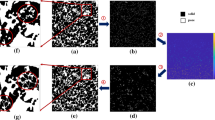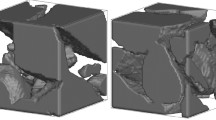Abstract
In this paper, the migration of supercritical carbon dioxide (\(\hbox {CO}_{2}\)) in realistic sandstone rocks under conditions of saline aquifers, with applications to the carbon geological storage, has been investigated by a two-phase lattice Boltzmann method (LBM). Firstly the digital images of sandstone rocks were reproduced utilizing the X-ray computed microtomography (micro-CT), and high resolutions (up to 2.5 μm) were applied to the pore-scale LBM simulations. For the sake of numerical stability, the digital images were “cleaned” by closing the dead holes and removing the suspended particles in sandstone rocks. In addition, the effect of chemical reactions occurred in the carbonation process on the permeability was taken into account. For the wetting brine and non-wetting supercritical \(\hbox {CO}_{2}\) flows, they were treated as the immiscible fluids and were driven by pressure gradients in sandstone rocks. Relative permeabilities of brine and supercritical \(\hbox {CO}_{2}\) in sandstone rocks were estimated. Particularly the dynamic saturation was applied to improve the reliability of the calculations of the relative permeabilities. Moreover, the effects of the viscosity ratio of the two immiscible fluids and the resolution of digital images on the relative permeability were systematically investigated.














Similar content being viewed by others
References
Taylor KC, Nasr-El-Din HA (1998) Water-soluble hydrophobically associating polymers for improved oil recovery: a literature review. J Petrol Sci Eng 19:265
Thomas S (2008) Enhanced oil recovery—an overview. Oil Gas Sci Technol Rev IFP 63:9
Emberley S, Hutcheon I, Shevalier M, Durocher K, Mayer B, Gunter W, Perkins E (2005) Monitoring of fluid–rock interaction and CO2 storage through produced fluid sampling at the Weyburn CO2-injection enhanced oil recovery site, Saskatchewan, Canada. Appl Geochem 20:1131
Marley MC, Hazebrouck DJ, Walsh MT (1992) The application of in situ air sparging as an innovative soils and ground water remediation technology. Ground Water Monit Remediat 12:137
Bedient P, Rifai H, Newell C (1994) Ground water contamination: transport and remediation. Prentice Hall, New York
Jiang F, Tsuji T, Hu C (2014) Elucidating the role of interfacial tension for hydrological properties of two-phase flow in natural sandstone by an improved lattice Boltzmann method. Transp Porous Media 104:205
Liu H, Valocchi AJ, Werth C, Kang Q, Oostrom M (2014) Pore-scale simulation of liquid CO2 displacement of water using a two-phase lattice Boltzmann model. Adv Water Resour 73:144
Huppert HE, Neufeld JA (2014) The fluid mechanics of carbon dioxide sequestration. Annu Rev Fluid Mech 46:255
Nordbotten JM, Celia MA, Bachu S (2005) Injection and storage of CO2 in deep saline aquifers: analytical solution for CO2 plume evolution during injection. Transp Porous Media 58:339
Borglin SE, Moridis GJ, Oldenburg CM (2000) Experimental studies of the flow of ferrofluid in porous media. Transp Porous Media 41:61
Tallakstad KT, Knudsen HA, Ramstad T, Lovoll G, Maloy KJ, Toussaint R, Flekkoy EG (2009) Steady-state two-phase flow in porous media: statistics and transport properties. Phys Rev Lett 102:074502
Wang X, Nguyen TV, Hussey DS, Jacobson D (2010) Experimental study of relative permeability of porous media used in PEM fuel cells. ECS Trans 33:1151
Bakke S, Oren PE (1997) 3D pore-scale modelling of sandstones and flow simulations in the pore networks. SPE J 2:136
Meakin P, Tartakovsky AM (2009) Modeling and simulation of pore-scale multiphase fluid flow and reactive transport in fractured and porous media. Rev Geophys 47:RG3002
Brackbill JU, Kothe DB, Zemach C (1992) A continuum method for modeling surface-tension. J Comput Phys 100:335
Sethian JA (1999) Level set methods and fast marching methods: evolving interfaces in computational geometry, fluid mechanics, computer vision and material science. Cambridge University Press, Cambridge
Unverdi SO, Tryggvason G (1992) A front-tracking method for viscous, incompressible, multi-phase flows. J Comput Phys 100:25
Hao L, Cheng P (2010) Pore-scale simulations on relative permeabilities of porous media by lattice Boltzmann method. Int J Heat Mass Transf 53:1908
Landry CJ, Karpyn ZT, Ayala O (2014) Pore-scale lattice Boltzmann modeling and 4D X-ray computed microtomography imaging of fracture-matrix fluid transfer. Transp Porous Media 103:449
Gunstensen AK, Rothman DH, Zaleski S, Zanetti G (1991) Lattice Boltzmann model of immiscible fluids. Phys Rev A 43:4320
Rothman DH, Zaleski S (1994) Lattice-gas models of phase-separation—interfaces, phase-transitions, and multiphase flow. Rev Mod Phys 66:1417
Rothman DH (2004) Lattice-gas cellular automata: simple models of complex hydrodynamics. Cambridge University Press, Cambridge
Redeker M, Rohde C, Sorin Pop I (2016) Upscaling of a tri-phase phase-field model for precipitation in porous media. IMA J Appl Math 81:898
Quintard M, Whitaker S (1994) Transport in ordered and disordered porous media II: generalized volume averaging. Transp Porous Media 14:179
Gray WG, Miller CT (2011) TCAT analysis of capillary pressure in non-equilibrium, two-fluid-phase, porous medium systems. Adv Water Resour 34:770
Chen SY, Diemer K, Doolen D, Eggert K, Fu C, Gutman S, Travis BJ (1991) Lattice gas automata for flow through porous-media. Physica D 47:72
Shan XW, Chen HD (1993) Lattice Boltzmann model for simulating flows with multiple phases and components. Phys Rev E 47:1815
Guo ZL, Zheng CG, Shi BC (2002) An extrapolation method for boundary conditions in lattice Boltzmann method. Phys Fluids 14:2007
He X, Chen S, Zhang R (1999) A lattice Boltzmann scheme for incompressible multiphase flow and its application in simulation of Rayleigh–Taylor instability. J Comput Phys 152:642
Luo LS (2000) Theory of the lattice Boltzmann method: lattice Boltzmann models for nonideal gases. Phys Rev E 62:4982
Inamuro T, T Ogata, Tajima S, Konishi N (2004) A lattice Boltzmann method for incompressible two-phase flows with large density differences. J Comput Phys 198:628
Aidun CK, Clausen JR (2010) Lattice-Boltzmann method for complex flows. Annu Rev Fluid Mech 42:439
Kuznik F, Luo LS, Krafczyk M (2013) Mesoscopic methods in engineering and science. Comput Math Appl 65:813
Chen SY, Doolen D (1998) Lattice Boltzmann method for fluid flows. Annu Rev Fluid Mech 30:72
Succi S (2001) Lattice Boltzmann equation for fluid dynamics and beyond. Oxford University Press, Oxford
Falcucci G, Ubertini S, Biscarini C, Francesco SD, Chiappini D, Palpacelli S, Maio AD, Succi S (2011) Lattice Boltzmann methods for multiphase flow simulations across scales. Commun Comput Phys 9:269
Swift MR, Osborn WR, Yeomans JM (1995) Lattice Boltzmann simulation of nonideal fluids. Phys Rev Lett 75:830
Swift MR, Orlandini E, Osborn WR, Yeomans JM (1996) Lattice Boltzmann simulations of liquid-gas and binary fluid systems. Phys Rev E 54:5041
Ramstad T, Oren PE, Bakke S (2010) Simulation of two-phase flow in reservoir rocks using a lattice Boltzmann method. SPE J 15:923
Ramstad T, Idowu N, Nardi C, Oren PE (2012) Relative permeability calculations from two-phase flow simulations directly on digital images of porous rocks. Transp Porous Media 94:487
Huang H, Lu Xy (2009) Relative permeabilities and coupling effects in steady-state gas-liquid flow in porous media: a lattice Boltzmann study. Phys Fluids 61:341
Zheng HW, Shu C, Chew YT (2005) Lattice Boltzmann interface capturing method for incompressible flows. Phys Rev E 72:056705
Zu YQ, He S (2012) Lattice Boltzmann modelling of migration for CO2 in porous media under conditions of saline aquifers. In: International symposium on heat transfer, ISHT-8, Beijing
Zu YQ, He S (2013) Phase-field-based lattice Boltzmann model for incompressible binary fluid systems with density and viscosity contrasts. Phys Rev E 87:043301
Qian YH, D'Humières D, Lallemand P (1992) Lattice BGK models for Navier–Stokes equation. Europhys Lett 17:479
Cahn JW, Hilliard JE (1958) Free energy of a nonuniform system. I. Interfacial free energy. J Chem Phys 28:258
Cahn JW, Hilliard JE (1959) Free energy of a nonuniform system. III. Nucleation in a two-component incompressible fluid. J Chem Phys 31:688
Li Q, Luo KH, Gao YJ, He YL (2012) Additional interfacial force in lattice Boltzmann models for incompressible multiphase flows. Phys Rev E 85:026704
Lee T, Fischer PF (2006) Eliminating parasitic currents in the lattice Boltzmann equation method for nonideal gases. Phys Rev E 74:046709
Spanne P, Thovert JF, Jacquin CJ, Lindquist WB, Jones KW, Adler PM (1994) Synchrotron computed microtomography of porous-media—topology and transports. Phys Rev Lett 73:2001
Lamy-Chappuis B, Angus D, Fisher Q, Grattoni C, Yardley BWD (2014) Rapid porosity and permeability changes of calcareous sandstone due to CO2 enriched brine injection. Geophys Res Lett 41:399
Chiquet P, Daridon JL, Broseta D, Thibeau S (2007) CO2/water interfacial tensions under pressure and temperature conditions of CO2 geological storage. Energy Convers Manag 48:736
Dullien FAL (1979) Porous media fluid transport and pore structure. Academic Press, New York
Cancelliere A, Chang C, Foti E, Rothman DH, Succi S (1990) The permeability of a random medium—comparison of simulation with theory. Phys Fluids A 2:2085
Pan C, Luo LS, Miller CT (2006) An evaluation of lattice Boltzmann schemes for porous medium flow simulation. Comput Fluids 35:898
Juanes R, Spiteri EJ, Orr FM, Blunt MJ (2006) Impact of relative permeability hysteresis on geological CO2 storage. Water Resour Res 42:W12418
Chalbaud C, Robin M, Lombard JM, Martin F, Egermann P, Bertin H (2009) Interfacial tension measurements and wettability evaluation for geological CO2 storage. Adv Water Resour 32:98
Nielsen LC, Bourg IC, Sposito G (2012) Predicting CO2-water interfacial tension under pressure and temperature conditions of geologic CO2 storage. Geochim Cosmochim Acta 81:28
Zu Y (2015) Modelling of migration of CO2 in porous media under conditions of saline aquifers using lattice Boltzmann method. Proc Eng 126:471
Acknowledgements
The authors were grateful to the financial support from the Engineering and Physical Science Research Council of the UK (Grant No. EP/I010971/1). J.F.X thanks the National Natural Science Foundation of China (Grant No. 51506110) and China Postdoctoral Science Foundation (Grant No. 2015M581090) for the support. Y.Q.Z thanks the support of Shanghai Pujiang Programme (Grant No. 14PJ1401600) and Fudan University Initiative Scientific Research Programme (Grant No. EZH2126504). J.F.X also thanks Professor Moran Wang from Tsinghua University for the very useful discussions about the carbon geological storage, and we gratefully acknowledge the anonymous reviewers for their valuable comments.
Author information
Authors and Affiliations
Corresponding author
Ethics declarations
Conflict of interest
On behalf of all authors, the corresponding author states that there is no conflict of interest.
Rights and permissions
About this article
Cite this article
Xie, JF., He, S., Zu, Y.Q. et al. Relative permeabilities of supercritical CO2 and brine in carbon sequestration by a two-phase lattice Boltzmann method. Heat Mass Transfer 53, 2637–2649 (2017). https://doi.org/10.1007/s00231-017-2007-6
Received:
Accepted:
Published:
Issue Date:
DOI: https://doi.org/10.1007/s00231-017-2007-6




